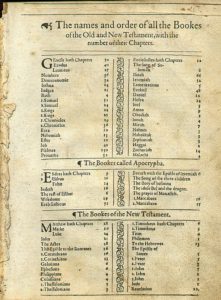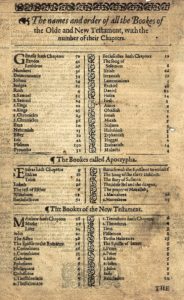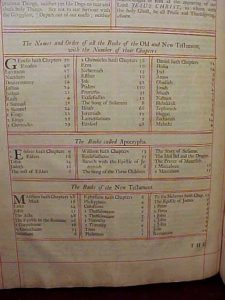The Apocrypha
Unknown to almost all of the over two billion people who claim the Bible as their spiritual foundation is that there are several books and two sections missing missing from all but a few versions of that Bible. Perhaps one of the best kept secrets of the modern Protestant church is that the Bible used by that body is not the original King James Bible. That translation, completed in 1611, and the Bibles published for the use of the clergy and the church members until late in the 19th Century, contained 80 books. Although attempts to remove the 14 books known as the Apocrypha from the Bible began immediately after the King James translation was completed they remained in the Bible until the end of the 19th Century. There is no doubt that the 14 books of the Apocrypha were controversial, but it cannot be denied they were included in the original King James Bible.
The concept of the Protestant Church about the Apocrypha is virtually non-existent, with the general understanding that only the Catholic Church uses it. One would be hard-pressed to find any members of the clergy even aware that these books were ever included in the King James Bible. There are 155,683 words and over 5,700 verses contained in 168 chapters now missing from the King James translation of the Bible due to the exclusion of the Apocrypha. Although this only happened just over a hundred years ago, their existence as fully accepted scripture is virtually unknown.
A clear history exists of the inclusion of the Apocrypha in the King James Bible:
- In the year 1615 Archbishop Gorge Abbott, a High Commission Court member and one of the original translators of the 1611 translation, “forbade anyone to issue a Bible without the Apocrypha on pain of one year’s imprisonment”
- “It should be observed that the Old Testament thus admitted as authoritative in the Church was somewhat bulkier and more comprehensive than the [Protestant Old Testament] . . . It always included, though with varying degrees of recognition, the so-called Apocrypha or Deutero-canonical books. The use made of the Apocrypha by Tertullian, Hippolytus, Cyprian and Clement of Alexandria is too frequent for detailed references to be necessary” (Early Christian Doctrines, J. Kelly)
- “In 405 Pope Innocent I embodied a list of canonical books in a letter addressed to Exsuperius, bishop of Toulouse; it too included the Apocrypha. The Sixth Council of Carthage (419) Re-enacted the ruling of the Third Council, again with the inclusion of the apocryphal books… “The Sixth Council of Carthage repromulgated in Canon 24 the resolution of the Third Council regarding the canon of scripture, and added a note directing that the resolution be sent to the bishop of Rome (Boniface I) and other bishops: ‘Let this be made known also to our brother and fellow-priest Boniface, or to other bishops of those parts, for the purpose of confirming that Canon [Canon 47 of the Third Council], because we have received from our fathers that these are the books which are to be read in church.’” (The Canon on Scripture, F. F. Bruce)
- “The holy ecumenical and general Council of Trent . . . following the example of the orthodox Fathers, receives and venerates all the books of the Old and New Testament . . . and also the traditions pertaining to faith and conduct . . . with an equal sense of devotion and reverence . . . If, however, any one receive not, as sacred and canonical, the said books entire with all their parts, as they have by custom been read in the Catholic Church, and as they are contained in the old Latin Vulgate, and knowingly and deliberately rejects the aforesaid traditions, let him be accursed.” (Decree of the Council of Trent in 1546)
- “In the name of Holy Scripture we do understand those canonical books of the Old and New Testament, of whose authority was never any doubt in the Church. . . And the other books (as Jerome saith) the Church doth read for example of life and instruction of manners: but yet doth it not apply them to establish any doctrine.” (Articles of Religion of the Church of England, 1563, Sixth Article)
Most early Bibles contained the Apocrypha; here are just a few:
- 1534 Luther’s German translation of the Bible
- 1534 The Coverdale Bible
- 1537 Thomas Matthew Bible
- 1539 The Taverner Bible
- 1541 The “Great” or “Cromwell’s” Bible
- 1551 The “Tyndale/ Matthews” Bible
- 1560 The Geneva Bible
- 1568 The Bishops’ Bible
- 1610 Catholic Old Testament
- 1611 King James Bible
- 1615 King James Version Robert Barker at London, England

1615 King James Version Robert Barker Bible - 1625 A King James Version

1625 King James Version Bible - 1717 King George 1st, AKA, The “Vinegar Bible”

1717 King George 1st Bible AKA The Vinegar Bible - 1782 The Aitken Bible
- 1791 The Family Bible
- 1846 The Illuminated Bible
The Apocrypha are also contained in the following:
- The Septuagint (LXX) – Except II Esdras.
- Codex Alexandrinus (A) – Also contains III & IV Maccabees
- Codex Vaticanus – Except I & II Maccabees and The defaulter of Manassah
- Codex Sinaiticus (Aleph)
- Codex Ephraemi Rescriptus – Includes Wisdom of Solomon and Ecclesiasticus
- Chester Beatty Papyri – Fragments of Ecclesiasticus
- The Dead Sea Scrolls – Some apocryphal writing was found among the Dead Sea Scrolls – interestingly written in Greek.
- Several writings of Church Fathers
Bibles are still available with Apocrypha:
- The Bible: Authorized King James Version with Apocrypha: Published by Oxford University Press; ISBN: 0192835254 (Pub. Date: July 1998)
- KJV Standard Reference Edition With Apocrypha: Published by Cambridge Univ Pr (Bibles); ISBN: 0521509467; Slipcase edition (Pub. Date: August 1997)
- 1611 Edition: a reprint of the 1611 KJV With Apocrypha, Published by Nelson Bible; ISBN: 0840700415; Reissue edition (Pub. Date: June 1, 1982)
- King James Version Lectern Edition: Published by Cambridge Univ Pr (Bibles); ISBN: 0521508169; (Pub. Date: March 1998)
- The Dake Annotated Reference Bible, Standard Edition: King James Version With Apocrypha, Published by Dake Publishing ISBN: 1558290699 (Pub. Date: April 1996)
For 275 years there were efforts to purge these the Apocrypha from the Bible:
- “APOCRYPHA, that is, Books which are not to be esteemed like the Holy Scriptures, and yet which are useful and good to read.” (Luther Bible, 1534)
- “The books and treatises which among the Fathers of old are not reckoned to be of like authority with the other books of the Bible, neither are they found in the Canon of Hebrew.” (Coverdale Bible 1535)
- “The books that follow in order after the Prophets unto the New Testament, are called Apocrypha, that is, books which were not received by a common consent to be read and expounded publicly in the Church, neither yet served to prove any point of Christian religion save in so much as they had the consent of the other scriptures called canonical to confirm the same, or rather whereon they were grounded: but as books proceeding from godly men they were received to be read for the advancement and furtherance of the knowledge of history and for the instruction of godly manners: which books declare that at all times God had an especial care of His Church, and left them not utterly destitute of teachers and means to confirm them in the hope of the promised Messiah, and also witness that those calamities that God sent to his Church were according to his providence, who had both so threatened by his prophets, and so brought it to pass, for the destruction of their enemies and for the trial of his children.” (Geneva Bible, 1560, Preface)
- The Synod of the Reformed Church held at Dordrecht in 1618 condemned the Apocrypha.
- “The books commonly called Apocrypha, not being of divine inspiration, are no part of the Canon of Scripture; and therefore are of no authority in the Church of God, nor to be any otherwise approved, or made use of, than other human writings.” (Westminster Confession, 1647)
- The thirty nine Articles of the Church of England in 1562 recognized this and rejected the canonicity of these apocryphal writings which the Roman church had proclaimed.
- In 1880 the American Bible Society voted remove the “Apocrypha” Books from the King James Version. These 14 Books [There are 155,683 words in over 5,700 verses in 168 Chapters] of the Apocrypha had been part of the King’s bible since 1611.
- The “Apocrypha” was officially removed from the English printings of the KJV by the Archbishop of Canterbury in 1885 leaving only 66 books.
There was a Preface written for the original King James Bible, which is mysteriously missing from that work: The Translator’s Preface
There was also a Dedication written for the original King James Bible: The Epistle Dedicatory